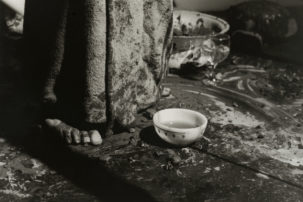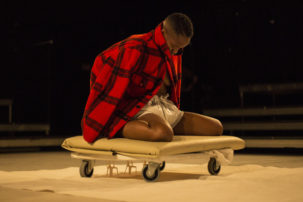“What temporal landscape does a clock embody?” The exhibition “Experimental Time Order” pivoted around this question, cut in vinyl on the wall and providing a point of departure from which to reconfigure our comprehension of time. Two works, Black Space Agency (2018) and All Time is Local (2018), formed a composition including several clocks of various designs, from different eras. The faces of these clocks contained collages composed of images of astronauts and newspaper clippings of advertisements for psychic readings, tactile magic and ways to attune to the “mind’s inner doors.” As a standardized time-keeping instrument, the clock embodies time within a clearly demarcated system of temporal progress. But with some of their minute and hour hands obscured, these ones were rendered functionless. Here, “Experimental Time Order” provided tools and methods that refused to flatten our experience of time.
In Time Travel Experiments (2017), the viewer was asked to recall a memory, and build upon it, to re-experience it, locating it within the past, present and future. Through this exercise of recall, Black Quantum Futurism (BQF) offered an understanding of memory and experience not as static or fixed but rather as a narrative mode of being that actively averts adherence to a linear concept of time. This DIY time-travel exercise emphasized the necessity to centre an embodied experience—changing the way we read, interpret and comprehend historical narratives and contemporary power structures.
The displayed collection of publications, zines and manuals published by Camae Ayewa and Rasheedah Phillips (members of BQF) presented a depth of research and writing, asking whom we call upon to be in the same space as ourselves, and whom we choose to think with and alongside. Their cross- disciplinary approach drew on deeply entangled histories, elevating and echoing the voices and actions of prominent Afro-diasporic Black thinkers and artists, including Octavia Butler, Stokely Carmichael, Sun Ra, Marcus Garvey, Black Experimental Music and Black Lives Matter, to name a few. Poetry, essays, science fiction, quantum physics, thought experiments, music and astrological charts offered conditions for imagining different frames of thinking and living.
Immaterial by nature, sound maintains a different register of time, and prompted a more sensorial engagement within “Experimental Time Order.” Eclectic compositions of spiritual/free jazz, experimental, spoken word, punk and hip hop were heard throughout the space, creating a distinct sonic dissonance. The works in the exhibition became less solid as they took on the inflections of the surrounding sound component, and the institutional boundaries of the gallery became less rigid in turn, as the aural frequencies dissolved the containment of individual works.
At a time when it often feels like we are deeply enmeshed and implicated within systems that deny us our agency, the propositions offered by BQF remind us that we determine our own experiences of time. BQF build community through their workshops, Black Womxn Time Camps, music and spoken word performances, social housing advocacy and their many collaborative projects. “Experimental Time Order” asserted that the ways we choose to embody time determine the processes that allow us to break from unjust systems, giving us the freedom to get out from under them. These propositions were a nuanced demand for transformative reclamations of time, creating moments for radical tenderness and support. Or, as Camae Ayewa states: “Offering hearts / as technology / Topowerthetimemachineof / after / Before / Now.”

 Installation view (detail) of Black Quantum Futurism’s “Experimental Time Order,” 2019. Photo: Dennis Ha
Installation view (detail) of Black Quantum Futurism’s “Experimental Time Order,” 2019. Photo: Dennis Ha







